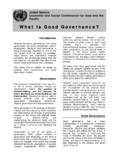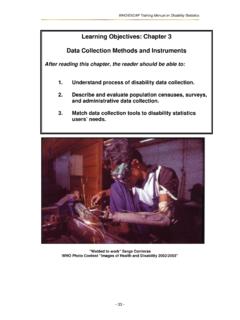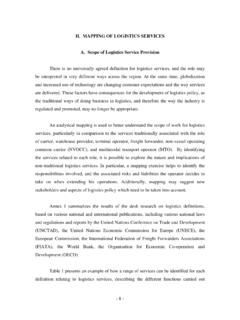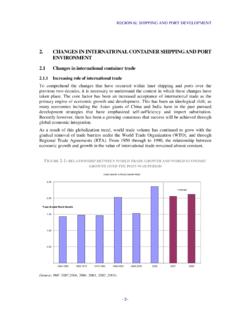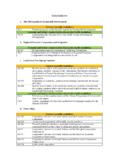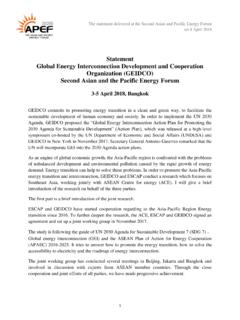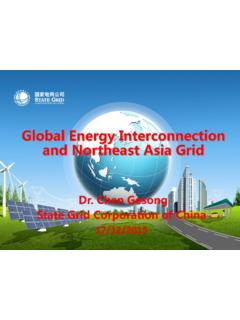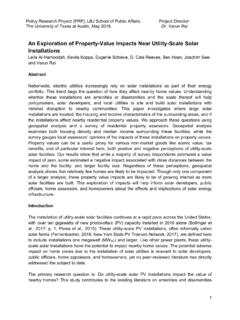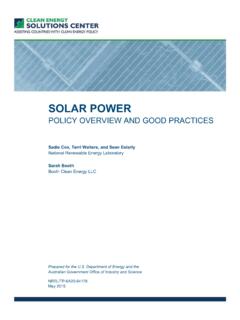Transcription of Low Carbon Green Growth Roadmap for Asia and the Pacific ...
1 Key points Decentralized energy systems can be used as a supplementary measure to the existing centralized energy system. Decentralized energy systems provide promising opportunities for deploying renewable energy sources locally available as well as for expanding access to clean energy services to remote communities. Decentralized energy system explainedA decentralized energy system is characterized by locating of energy production facilities closer to the site of energy consumption. A decentralized energy system allows for more optimal use of renewable energy as well as combined heat and power, reduces fossil fuel use and increases decentralized energy system is a relatively new approach in the power industry in most countries. Traditionally, the power industry has focused on developing large, central power stations and transmitting generation loads across long transmission and distribution lines to consumers in the region.
2 Decentralized energy systems seek to put power sources closer to the end user. End users are spread across a region, so sourcing energy generation in a similar decentralized manner can reduce the transmission and distribution inefficiencies and related eco-nomic and environmental it worksInfrastructure componentsA decentralized system relies on distributed generation, energy storage and demand response: distributed generation: The core component of a decentralized energy system is distributed generation, also known as embedded generation, on-site generation, dispersed generation and decentralized generation. Both heat and electricity can be generated in a decentralized manner. But heat cannot be transported over long distances; thus it has been traditionally generated onsite. Shifting to decentralized power generation allows for coordinating between heat and power generation in combined heat and power plants.
3 Doing that increases the system s efficiency with electricity and heat production because heat is a by-product of many electricity-generating techniques. Energy storage: An important limitation in the distribution of electricity has been that electrical energy cannot be stored and must be generated as needed. Adding more generation sources in a decentralized system can lead to new difficulties in controlling supply to best match demand. However, such storage techniques as batter-ies, compressed air and pumped hydro storage can help keep the grid stable by storing energy when supply exceeds demand and feeding it back into the grid during peak hours. Storage is particularly helpful for intermit-tent renewable energy plants, which often produce at their highest capacities during non-peak hours. As with generation, storage can and should also be decentralized to maximize its efficiency; it can be off-grid or grid-connected.
4 Demand response: Demand-response technologies provide another tool to manage grid stability when decen-tralized generation is grid-connected. Conventionally, grid management has focused on supply management. But new technologies, including smart grid and smart metering, allow for real-time monitoring and communica-tion between producers and consumers of electricity to optimize grid usage. In fact, with distributed generation and storage, many consumers of electricity will also at times be producers of energy. Implementing smart grid technologies to facilitate grid management is necessary to building a truly decentralized energy system. Infrastructure designDistributed generation facilities may be connected to the grid or simply serve a particular site without feeding potential excess generation into the grid. Grid connected: distributed electricity generation can be connected to a central grid, such as in commercial or industrial plants that have their own power production facilities but can sell excess power to the grid or to a mini-grid to serve regions located far from the central grid.
5 As countries further develop their central grid system, mini-grids can be upgraded to form a distribution network that is connected to a larger transmission network. Linking distributed generation resources through a grid system increases their reliability, particularly when using intermit-tent renewable resources. Additionally, heat generated from CHP can be connected to distribution pipelines to serve a district. Off-grid: Electricity demand management and energy storage, although at a smaller scale, are still important components of an off-grid decentralized energy system. Even a solar home system for a single housing unit oper-ates most efficiently with battery storage and if the users manage their own loads to best match supply fluctua-tions. Heat generated from CHP can also serve a single site, requiring fewer infrastructures to transmit heat to neigh-bouring in Asia and the PacificRural electrification: Because grid integration of distributed generation and storage requires major technical upgrades, countries in the region can focus on distributed generation for rural electrification either through off-grid or mini-grid systems.
6 Increases in the share of renewable energy: A decentralized energy system is designed to accommodate many energy sources, including the renewable sources with intermittent production, such as wind and solar . Distrib-uted generation, demand management and storage can all facilitate increased inflows of renewable in using a decentralized systemEnvironmental The use of CHP, made possible through the decentralizing of electricity production, also increases the overall heat and power system s efficiency and thereby reduces harmful greenhouse gas distributed generation sources often have lower capital costs per project, compared to large central power plants. In some circumstances, off-grid distributed generation can reduce the need for expensive transmission and distribution network expansion.
7 Lower losses through the lengthy transmission of electricity increases eco-efficiency. Reducing losses in transmission and distribution and the incremental addition to capacity through distributed generation can help defer investment in large central power plants. Decentralized siting of energy generation facilities requires decentralized businesses to construct, operate and maintain the facilities, creating opportunities for local business and job creation. Decentralized energy systemFACT SHEETLow Carbon Green Growth Roadmap for Asia and the PacificKey points Decentralized energy systems can be used as a supplementary measure to the existing centralized energy system. Decentralized energy systems provide promising opportunities for deploying renewable energy sources locally available as well as for expanding access to clean energy services to remote communities.
8 Decentralized energy system explainedA decentralized energy system is characterized by locating of energy production facilities closer to the site of energy consumption. A decentralized energy system allows for more optimal use of renewable energy as well as combined heat and power, reduces fossil fuel use and increases decentralized energy system is a relatively new approach in the power industry in most countries. Traditionally, the power industry has focused on developing large, central power stations and transmitting generation loads across long transmission and distribution lines to consumers in the region. Decentralized energy systems seek to put power sources closer to the end user. End users are spread across a region, so sourcing energy generation in a similar decentralized manner can reduce the transmission and distribution inefficiencies and related eco-nomic and environmental it worksInfrastructure componentsA decentralized system relies on distributed generation, energy storage and demand response: distributed generation: The core component of a decentralized energy system is distributed generation, also known as embedded generation, on-site generation, dispersed generation and decentralized generation.
9 Both heat and electricity can be generated in a decentralized manner. But heat cannot be transported over long distances; thus it has been traditionally generated onsite. Shifting to decentralized power generation allows for coordinating between heat and power generation in combined heat and power plants. Doing that increases the system s efficiency with electricity and heat production because heat is a by-product of many electricity-generating techniques. Energy storage: An important limitation in the distribution of electricity has been that electrical energy cannot be stored and must be generated as needed. Adding more generation sources in a decentralized system can lead to new difficulties in controlling supply to best match demand. However, such storage techniques as batter-ies, compressed air and pumped hydro storage can help keep the grid stable by storing energy when supply exceeds demand and feeding it back into the grid during peak hours.
10 Storage is particularly helpful for intermit-tent renewable energy plants, which often produce at their highest capacities during non-peak hours. As with generation, storage can and should also be decentralized to maximize its efficiency; it can be off-grid or grid-connected. Demand response: Demand-response technologies provide another tool to manage grid stability when decen-tralized generation is grid-connected. Conventionally, grid management has focused on supply management. But new technologies, including smart grid and smart metering, allow for real-time monitoring and communica-tion between producers and consumers of electricity to optimize grid usage. In fact, with distributed generation and storage, many consumers of electricity will also at times be producers of energy. Implementing smart grid technologies to facilitate grid management is necessary to building a truly decentralized energy system.
